The Monstera Thai Constellation is a popular and stunning houseplant known for its striking cream and green variegated leaves, which feature large holes reminiscent of a starry constellation. As a variegated Monstera deliciosa, this eye-catching plant is grown from tissue culture in Thailand. It is loved by houseplant enthusiasts not only for its unique appearance, but also for its stable variegation, resilience, and relatively easy care.
While the Monstera Thai Constellation has many advantages, it does come with a few challenges. The plant requires more light compared to other Monstera varieties and is prone to root rot, making proper care crucial for its health. In this article, we’ll guide you step-by-step in understanding and catering to the needs of this beautiful houseplant. You will learn everything from light requirements and watering habits to pruning and dealing with potential pests and diseases.
Key Takeaways:
- Proper care is essential for maintaining the Monstera Thai Constellation’s unique appearance and healthy growth
- Light, watering, and soil are key factors in the plant’s care
- Pruning, propagation, and managing pests are important components of maintaining a thriving Monstera Thai Constellation
Light Requirements
When it comes to Monstera Thai Constellation, light plays a crucial role in its growth and variegation. This plant variety needs more light than other Monstera species because the cream-colored parts of its leaves cannot photosynthesize. As a result, they rely on the green parts of the leaves to produce energy. Without enough light, your Thai Constellation will grow slowly, lose its variegation, or become leggy.
To provide optimal light conditions for your Monstera Thai Constellation, place the plant near a window that receives bright indirect light for at least 6 to 8 hours a day. While they need more light, direct sunlight should be avoided as it can scorch the plant’s leaves.

It’s important to rotate your plant occasionally to ensure even growth and maintain its beautiful variegation. This will help all parts of the plant receive equal exposure to the light source, promoting healthy growth.
In situations where natural light is insufficient or inconsistent, you may want to consider using artificial grow lights. These can give your Monstera Thai Constellation the light it needs to thrive, even in low light conditions. A friendly reminder to keep your plant’s light requirements in mind to ensure it remains healthy and vibrant.
Watering Frequency and Amount
Caring for your Monstera Thai Constellation involves understanding its watering needs. To maintain the appropriate moisture levels, water your plant when the top 2 to 3 inches of soil are dry to the touch. Depending on factors such as the season, pot size, and indoor temperature, this may mean watering once a week or less.
Avoid overwatering, as it can lead to issues like root rot, yellowing, or wilting. To ensure you’re providing the right amount of water, follow these tips:
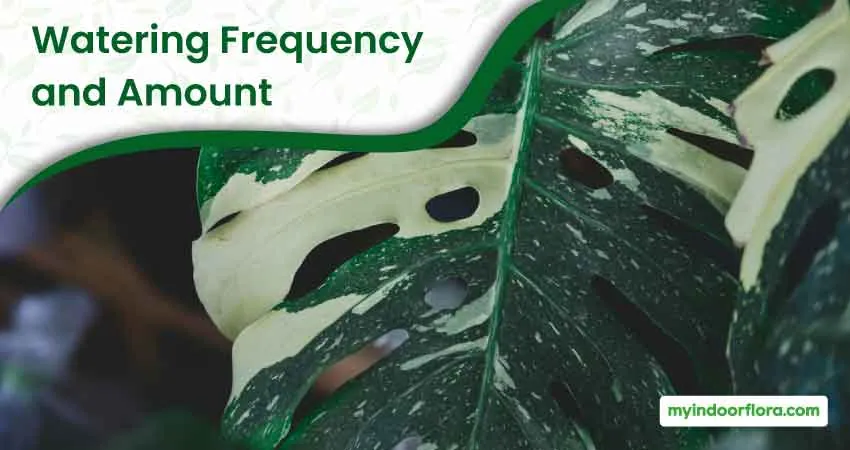
- Use room temperature water that is filtered or dechlorinated to prevent any chemical buildup in the soil.
- Water thoroughly until you see water draining out of the bottom of the pot. This ensures the water reaches the roots and promotes healthy growth.
- After watering, empty the saucer or tray beneath the pot to prevent standing water, which can also lead to root rot and other problems.
Regularly monitoring the soil moisture is essential for your Monstera Thai Constellation’s health. You can check the moisture levels by simply using your finger or investing in a moisture meter for more accurate readings. By following these watering guidelines, you’ll help your Monstera Thai Constellation thrive and enjoy its beautiful variegated leaves.
Soil Type and Drainage
When it comes to the best type of soil for your Monstera Thai Constellation, you should look for a well-draining soil mix that is rich in organic matter and nutrients. The soil should be light and airy so it allows oxygen to reach the roots, while also retaining some moisture without becoming soggy or compacted.
To prepare and maintain the perfect soil for your Monstera Thai Constellation, you can start with a peat-based potting mix and add perlite, bark, or coco coir for better drainage. Additionally, incorporating some worm castings, compost, or slow-release fertilizer ensures the soil has enough nutrition to support your plant’s growth.
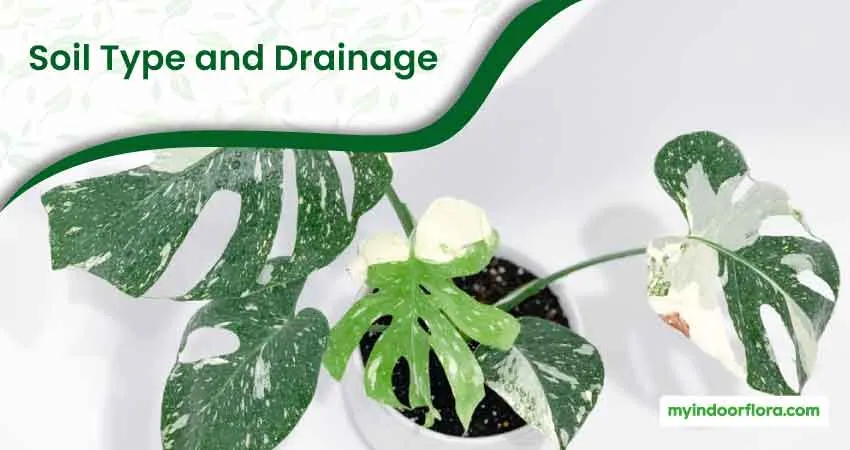
Repotting your Monstera Thai Constellation should be a part of your plant care routine, ideally every 1 to 2 years or when you notice it has outgrown its current pot. When choosing a new pot, make sure it has drainage holes and is only slightly larger than the existing root ball. This will ensure the right balance of moisture and proper drainage for the plant’s health.
By using the right soil mix, maintaining proper drainage, and following these care tips, you’ll be on your way to having a thriving Monstera Thai Constellation.
Humidity and Temperature Preferences
As a tropical plant, your Monstera Thai Constellation prefers a warm, humid environment. Ideally, it should be kept in a space with humidity levels of 60% or more and temperatures ranging from 65 to 85°F (18 to 29°C). Importantly, be mindful that this plant cannot tolerate freezing temperatures or cold drafts, so it is essential to keep it away from such conditions.
There are several ways you can help maintain the preferred humidity and temperature levels for your Monstera Thai Constellation. One method is misting the leaves regularly with a spray bottle, or you can place a humidifier near the plant to maintain the humidity. Grouping your Monstera with other humidity-loving plants is another natural way to create a more humid microclimate.

Another option is to place the plant on a tray of pebbles filled with water. As the water evaporates, the humidity around your plant will increase. Just make sure the pot isn’t sitting directly in the water to avoid root rot.
In terms of temperature, it’s essential to position your Monstera Thai Constellation away from heating vents, air conditioners, or windows that face north or east, as these can create undesirable temperature fluctuations. Moreover, adjust your thermostat accordingly during winter or summer months to maintain a consistently warm environment for your plant.
Fertilizer Needs and Schedule
Fertilizing your Monstera Thai Constellation is essential to promoting healthy growth, maintaining its beautiful variegation, and encouraging flowering. During the growing season, which typically falls during spring and summer, it’s important to provide your plant with the right nutrients.
To achieve this, use a balanced liquid fertilizer diluted to half strength once a month. This type of fertilizer is suitable for foliage or tropical plants and will provide the essential nutrients your Monstera needs. Make sure to avoid fertilizing during fall and winter, as the plant will be dormant or slow-growing during these seasons and will not require additional nutrients.
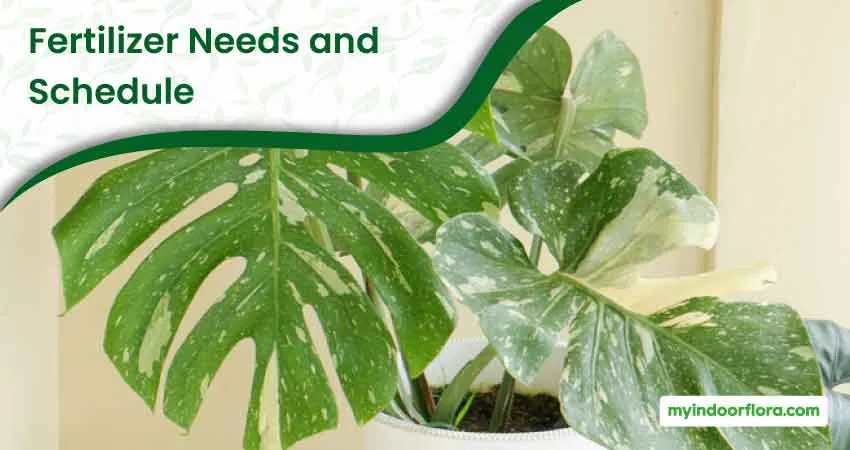
When it’s time to fertilize your Monstera Thai Constellation, follow these tips to ensure you’re doing it safely and effectively:
- Water your plant before fertilizing. This will help to prevent the fertilizer from burning the plant’s delicate roots.
- Follow the label instructions. Each fertilizer may have specific ratios and guidelines for diluting, so make sure to adhere to these for the best results.
- Do not over-fertilize. Over time, excessive fertilizer may result in a buildup of salts within the soil, negatively impacting your plant’s health.
Worm castings are another excellent source of nutrients that you can use as an alternative or supplement to liquid fertilizer. By adding a tablespoon or two of worm castings to the top layer of the soil, you’ll be providing additional nutrients to your Monstera Thai Constellation in a more natural form.
Lastly, be sure to flush the soil with water every few months to minimize any salt buildup. This will ensure that your Monstera Thai Constellation receives the nutrients it needs while also protecting it from potential harm caused by excessive fertilization.
Pruning and Propagation Methods
Pruning your Monstera Thai Constellation not only helps control its size, shape, and overall health but also encourages new growth. To prune, use a sharp and sterile knife or scissors to cut off any dead, damaged, or diseased leaves or stems. Make the cut just above a leaf node or an aerial root. Dispose of the pruned parts, or you can use them for propagation.
When it comes to propagating your Monstera Thai Constellation, there are two popular methods: stem cuttings and air layering. Both methods can result in a healthy, thriving new plant.
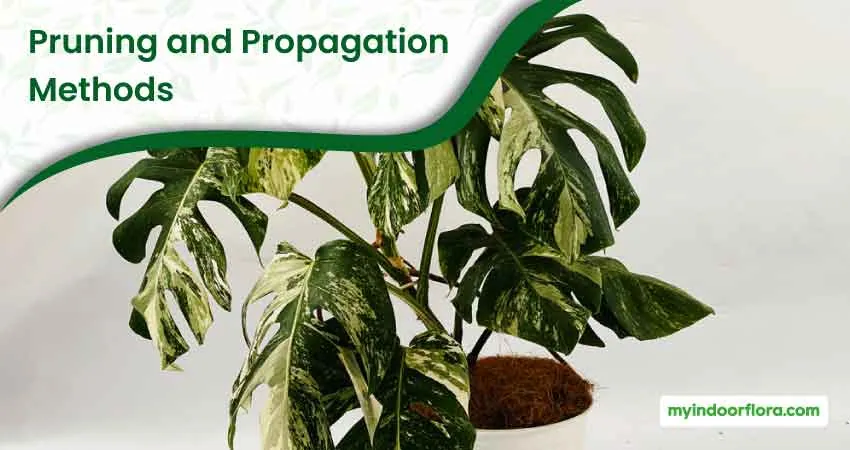
Stem cuttings: To propagate using stem cuttings, cut a stem from the main plant, making sure to include at least one leaf node. Place the stem in water, and wait for it to develop roots. It might take a few weeks, and once the roots are about an inch long, transfer the stem to a pot with moist soil. Water regularly, keeping the soil moist but not soggy. In no time, you will have a new Monstera Thai Constellation plant to admire.
Air layering: For air layering, choose a stem that has a leaf node and an aerial root. Make a small incision on the stem, and insert a toothpick or piece of wire to keep the wound open. Next, wrap some moist sphagnum moss around the wound and secure it with plastic wrap or foil. Wait for roots to form inside the moss, which may take several weeks or months. Once you see roots forming, cut off the stem below the moss ball and pot it in soil.
With these pruning and propagation methods, you can maintain your Monstera Thai Constellation and even enjoy the satisfaction of growing new plants from your existing one. Happy gardening!
Common Pests and Diseases and How to Prevent and Treat Them
Monstera Thai Constellation plants may be affected by common pests such as spider mites, mealybugs, scale insects, thrips, and aphids. It’s also prone to diseases such as root rot, leaf spot, bacterial wilt, and fungal infections. To maintain your plant’s health, it’s important to manage these issues.
Preventing pests and diseases starts with proper plant care. Keep the leaves clean and dust-free by wiping them with a damp cloth or giving your plant an occasional shower. Regularly inspect your plant for any signs of infestation and isolate it from other plants if necessary. Avoid overwatering, underwatering, overfertilizing, or exposing your plant to extreme temperatures or light conditions, as these can weaken the plant and make it more susceptible to problems.
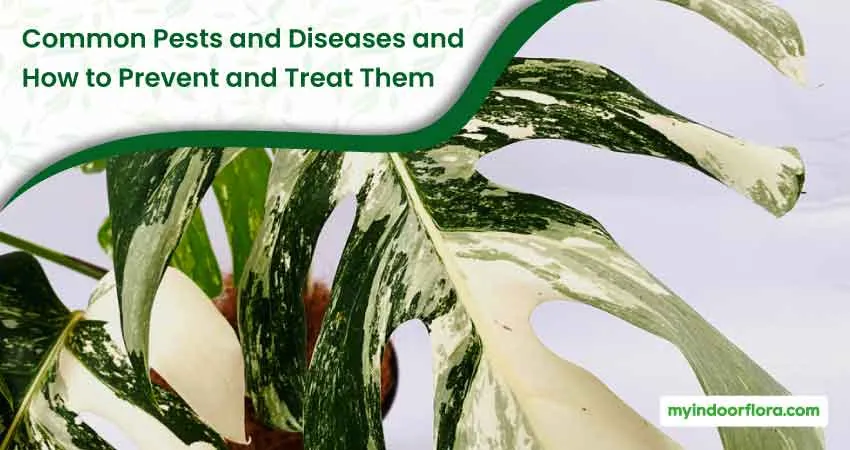
When treating infestations of pests like spider mites, mealybugs, scale insects, thrips, or aphids, you can use a cotton swab dipped in alcohol to wipe off the visible pests or their eggs. Follow this by spraying your plant with insecticidal soap, neem oil, or horticultural oil according to label instructions. Repeat the treatment every few days until the pests are eliminated.
If your Monstera Thai Constellation experiences diseases such as root rot, leaf spot, bacterial wilt, or fungal infections, start by carefully removing any affected leaves or stems and disposing of them properly to prevent spreading. Treat your plant with a fungicide or bactericide following label instructions. If necessary, repot your plant in fresh soil and improve drainage and ventilation around the plant to prevent further issues.
By keeping an eye on your Monstera Thai Constellation and maintaining the appropriate care, you can prevent and treat common pests and diseases, ensuring your plant remains healthy and beautiful.
